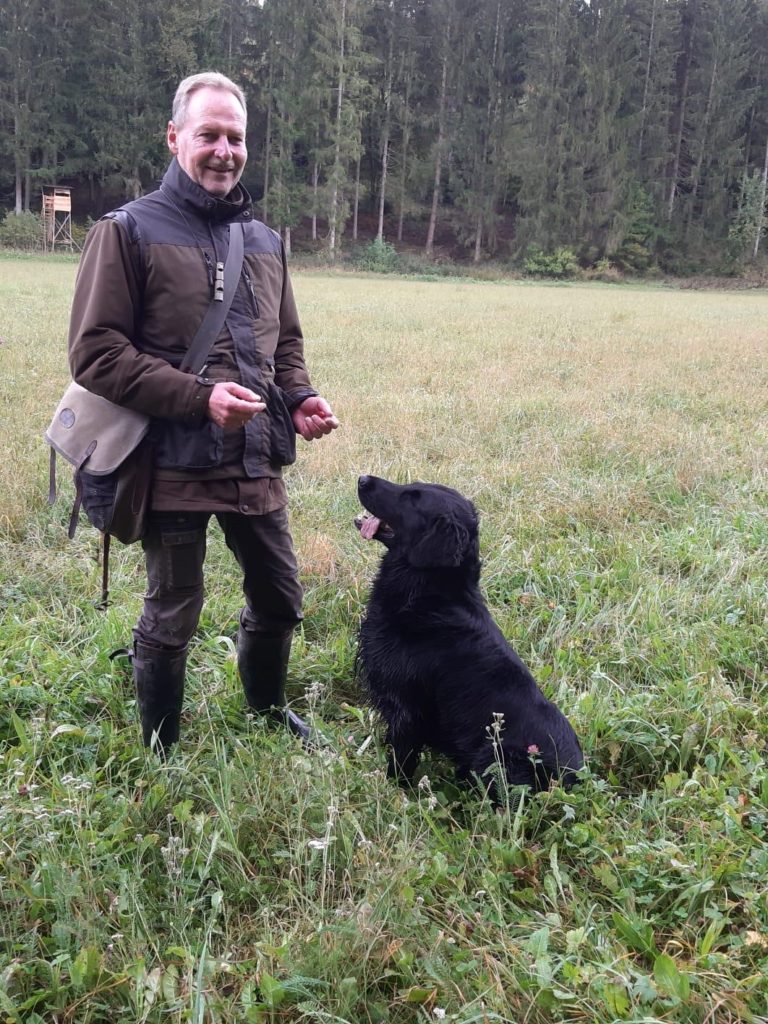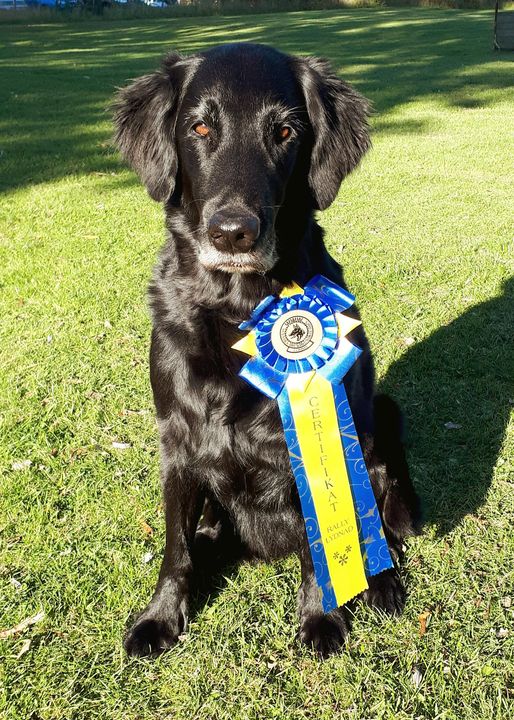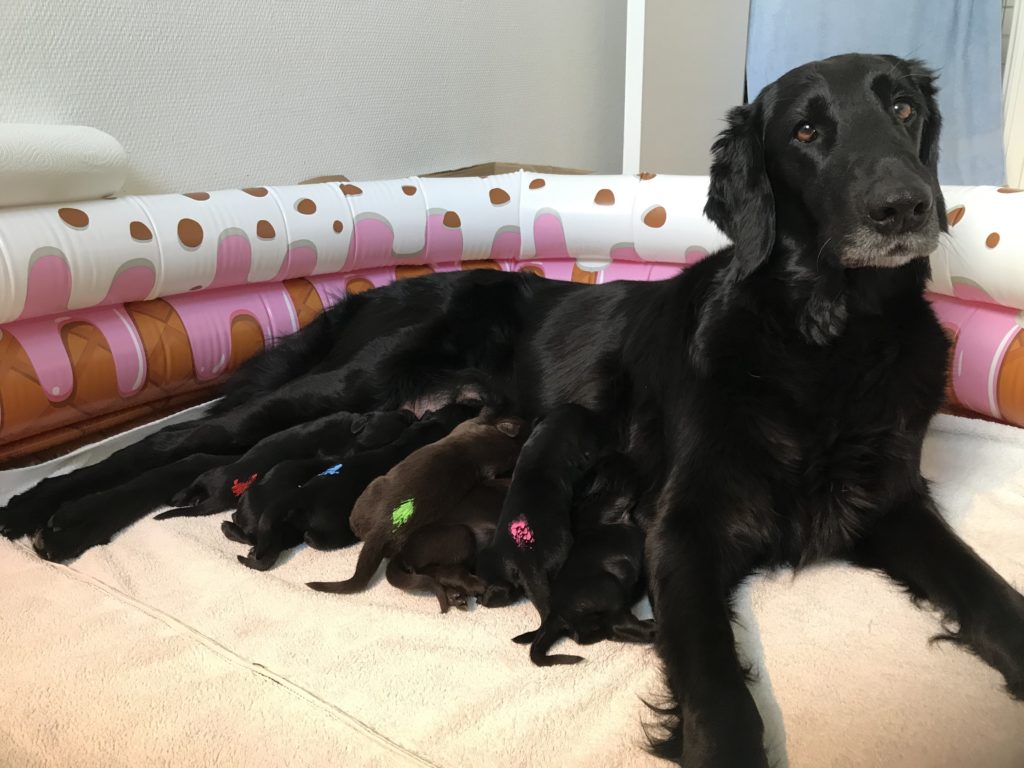Hälsning från Tyskland och Manfred
Anniversary PnS 2020
This year, the post-shot (PnS) examination took place for the 25th time. As in all the years before in Königsbronn under the examination supervision of Jörg Mente.
This elite examination of the DRC is only held once a year; usually for 5 dogs. Rarely in the past 25 years have more than these five places been required.
In contrast to this, the demand for examination places for all other hunting examinations has been increasing continuously for years.
Now one might ask why this does not apply to PnS. Here too, ”only” the usual subjects such as welding track, lost-and-found search, towing, water work and briefing/marking are tested.
And yet it is very special in Königsbronn: 1st day
600 m of sweat at dressing welding track level; this track is therefore only produced with 150 ml of wild sweat.
The special feature: no judge’s accompaniment; the dog handler is shown the shot and the direc- tion of escape, then a strong search success is wished and then he has 90 minutes alone with his dog to find the track. Four wound beds have been made on the trail, in which stalking signs (spe- cially marked coins) are found. These are to be collected in order to document the dog’s loyalty to the track and to give the judges an indication of the rating to be awarded.
Lost search in the forest at Btr – level:
The special feature: Only one piece of game is laid out. Either a fox is found at 100 m or alterna- tively a hare at 80 m.
500 m of hairy game drag:
Special feature: the train is drawn with a hare and not with a rabbit as usual. This means that the requirements for the dog’s way back are completely different. On the one hand the length of the train plays a role, but much more important is the weight of the hare. Due to these circumstances, experienced dogs have in the past sometimes not found their way back to their handler.
In the end, the difficulty of the individual woodland sections is determined by the nature of the ter- rain; large forest areas with dense vegetation and often blackberries as ground cover.
2nd day
Marking of a towing lane: on the opposite side of a river approx. 30 m wide, at a distance of ap- prox. 10 m from the edge of the bank, a connection is marked and from there an approx. 100 m long tow is towed. From this side of the river, the dog is sent across the water and on the other side the dog is instructed on the approach. He must independently accept the drag, work it out and bring the duck. If the dog has reached the water on its return, another duck is thrown sideways from it onto the water with a scrap shot. He must first complete the ap-port that has been started.
Lost in the water: after the required steering ability when the dog is directed into the towing lane, the dog should now show independent work. At a distance of about 25 m from the edge of the shore there is an island about 50 m wide and 10 m deep with strong reed growth about 2 m high. The other side of the shore is about 10 m away from the island. One duck is laid out on the island and a second one on the other bank. Finding the duck on the island is not a major problem for the dog being hunted. Leaving the island in search of the second duck and searching the opposite shore requires a high degree of independence, hunting instinct and hunting savvy.
An additional challenge for the dog on the day of the test was posed by numerous curious swans in the immediate vicinity of the search area.
Instruction in the field – marking – resting: before the start of the task, 5 ducks are laid out in a clearing, not visible to the dogs, on the edge of the forest at a distance of approx. 30 m from each other in high vegetation. All dogs then sit unleashed next to their handlers, positioned at the oppo- site edge of the forest. Only the dog called to work stands on the meadow and can see the mark- ings that have been ejected. Before he is allowed to retrieve it, he should be introduced to a duck specified by the judges.
The distances to the marking and to the briefing are each about 100m. These are the subjects to be completed.
What is the reason why dog handlers no longer present their dog at this test? From my point of view there are several aspects:
1. the versatility of the subjects, which are not found on any other elite test in the DRC.
2. the canon of subjects, through the alternation of independent work and the required manageabil- ity.
- the necessary fitness and concentration for 2 days of testing.
- the immense effort to prepare a dog for this level of testing.
- finally, it is also true that not all dogs are ”born” to be able to take this level of examinationrequired level.
In this respect, I respect all handlers who have led their dog in this test. In the past 25 years there have been 116 dogs; certainly all well prepared. Nevertheless, only around 50% have passed. In the end, the luck of the search can sometimes decide whether a dog is successful or not.
Finally, I would like to thank the district authorities and the judges Dr. Friedrich, Dr. Schwab and Mrs. Schoenbach.
Special thanks are due to Jörg Mente and his wife Barbara.
Jörg for 25 years of untiring commitment in the preparation and execution of this examination and Barbara, who has been providing exceptional hospitality and support for the examination partici- pants on both days for 25 years.
My personal thanks go to my daughter Daniela, who actively supported me in preparing my Snörre for this exam.
Congratulations to all those who were able to pass this most demanding elite exam in the DRC in its anniversary year.
1st place and CACT Manfred Pauels with Skattkammarens Call of Duty (Snörre) FCR, R 2nd place Bianca Willems-Hansch with AVA from Grumsmühlen LR, H
3rd place Christian Böse-Baer with Phinegan Coda of Golden Summerby GR, R
Manfred Pauels



